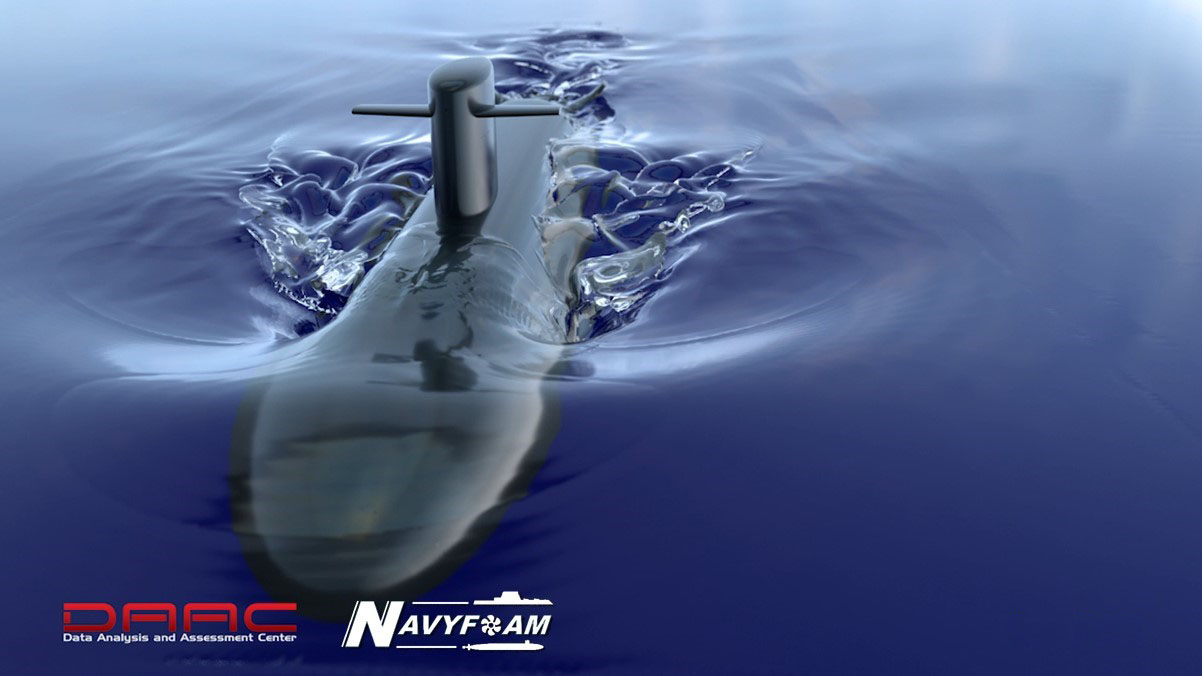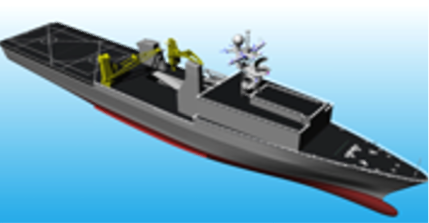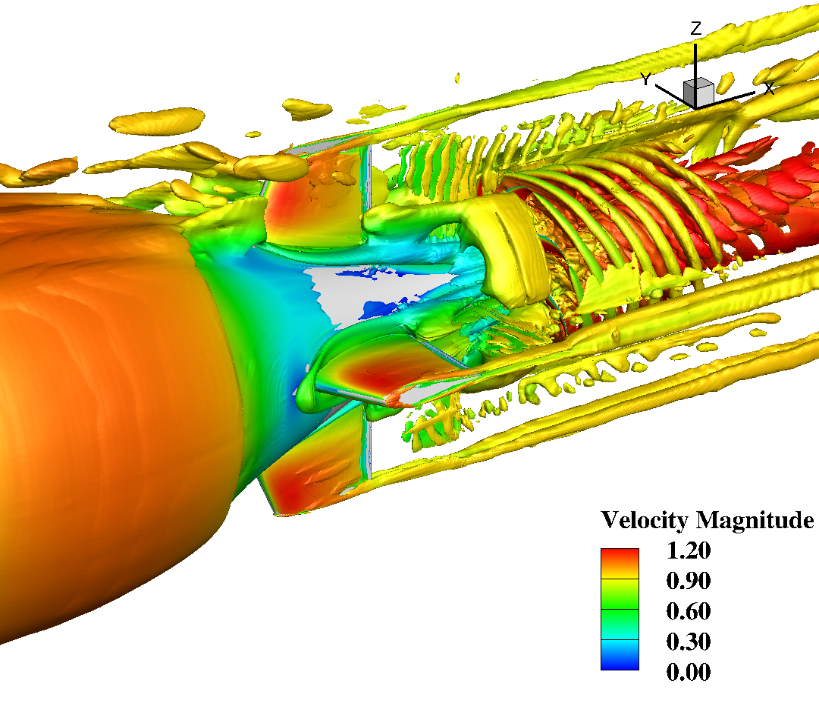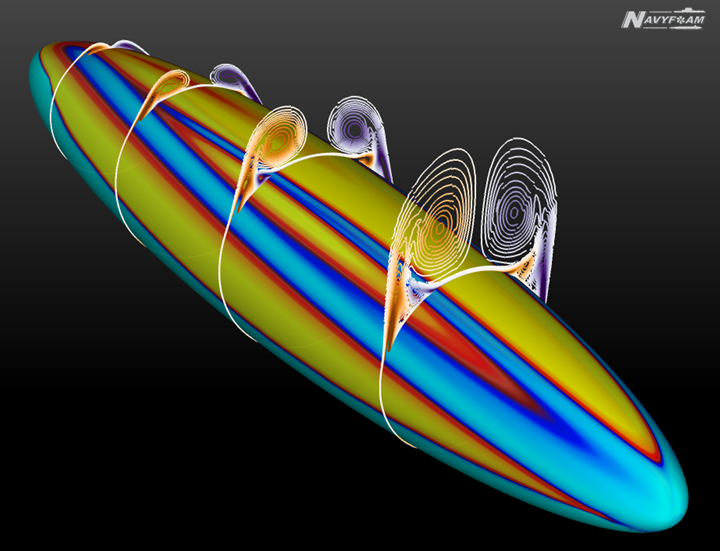


Joubert submarine predictions made using HPCMP CREATE™-Ships NavyFOAM, post-processed by HPC Data Analysis Assessment Center (DAAC)
CREATE-SH (Ships)
The overarching goals of the CREATE-Ships project are to develop software that enables comprehensive exploration of trade-space design options for complex maritime systems; provide confidence in the results of computational predictions in required disciplines across all phases of the acquisition process; and meet required acquisition timelines for DoD clients, primarily the US Navy. Our software suite includes: RSDE, IHDE, NavyFOAM, NESM, and ISDE.
 RSDE is a concept design tool that allows engineers and naval architects
to assess the trade-offs inherent in designing ships to meet a spectrum of
competing performance parameters. RSDE provides the following critical capabilities:
1) Generates a wide range of ship concept options with corresponding design and
analysis data, 2) Supports a set-based design down-selection process leading to
the discovery of low-cost, robust, candidate design solutions; and 3) Develops
data for physics-based response surfaces to aid in the visualization of design,
cost, and performance trade-offs of a multi-dimensional design space.
RSDE is a concept design tool that allows engineers and naval architects
to assess the trade-offs inherent in designing ships to meet a spectrum of
competing performance parameters. RSDE provides the following critical capabilities:
1) Generates a wide range of ship concept options with corresponding design and
analysis data, 2) Supports a set-based design down-selection process leading to
the discovery of low-cost, robust, candidate design solutions; and 3) Develops
data for physics-based response surfaces to aid in the visualization of design,
cost, and performance trade-offs of a multi-dimensional design space.
Employing the concept of design space exploration, RSDE enables engineers and naval architects to provide data for decision makers on the impact of trade-offs in capability, such as range, speed, armament, and aviation support versus cost drivers of a proposed ship concept. RSDE can generate tens of thousands of candidate ship designs with varying hull form size and shape, systems, structures, powering, and payloads. To date, RSDE has been used to support set-based design on numerous Navy acquisition programs, providing data necessary to enable the set-based down-selection process, as well as additional design information and reduced uncertainty. The RSDE effort is also supporting the development of a submarine design space exploration tool to support similar capabilities for submarine platform design.

Rendering of RSDE designed LSD 41/49 Equivalent Baseline Design
 IHDE is a workbench-like desktop application that integrates a suite of
hull form design and analysis tools for users to evaluate hydrodynamic performance,
including visualization, in a simplified and timely manner. IHDE provides a
highly-automated environment that allows naval architects and hydrodynamicists to
build computational models, submit "jobs" to local or HPC resources, and retrieve
and validate results for various required areas of hydrodynamics, and at varying
levels of fidelity. Ship hull designers are able to assess ship performance in
areas of resistance, seakeeping, hydrodynamic loads, and operability in the form
of percent time operable (PTO) for several different mission types. The development
plan calls for additional capabilities related to ship powering and maneuvering
performance characterization and multi-objective hull form optimization.
IHDE is a workbench-like desktop application that integrates a suite of
hull form design and analysis tools for users to evaluate hydrodynamic performance,
including visualization, in a simplified and timely manner. IHDE provides a
highly-automated environment that allows naval architects and hydrodynamicists to
build computational models, submit "jobs" to local or HPC resources, and retrieve
and validate results for various required areas of hydrodynamics, and at varying
levels of fidelity. Ship hull designers are able to assess ship performance in
areas of resistance, seakeeping, hydrodynamic loads, and operability in the form
of percent time operable (PTO) for several different mission types. The development
plan calls for additional capabilities related to ship powering and maneuvering
performance characterization and multi-objective hull form optimization.
The IHDE also includes an analysis tool validation engine, which provides the user with validation information by leveraging historical model test data and best-practice precomputed solutions for user-driven comparisons. The advantages of the IHDE include automated analysis preparation, automated grid generation, and integrated visualization. The Leading-Edge Architecture for Prototyping Systems (LEAPS) product model is used to manage geometry and analysis information, and allows data sharing between several knowledge domains.
LEAPS provides a warehouse for ship model information, which provides distinct advantages in maintaining an accurate ship ontology:
- Interoperability for different activities which already use LEAPS;
- Creation of a foundation of common terms across different disciplines for ship geometries and characteristics, thereby preventing translation errors; and
- Synergy in software development and integration using a common product model that can be shared with other activities, eliminating inefficient and time-consuming resetting of the same ship modeling inputs when using different analysis methods.
The IHDE utilizes a LEAPS database as a starting point for any hydrodynamic analysis, and is further enabled by the use of the LEAPS Morpheus preprocessor to define the ship model from CAD information. The end-state vision for the IHDE is to provide an integrated suite of design and analysis tools that cover a range of fidelity and corresponding computational expense, in order to fully characterize a ship design concept across relevant ship performance areas with an appropriate level of definition. The advantages of the IHDE include automation of analysis preparation, improving efficiency and reducing input errors, automated grid generation, parallel execution, and integrated visualization capabilities.

NavyFOAM prediction of generic submarine model undergoing crashback maneuver.
 The HPCMP CREATE™-SH NavyFOAM tool is a high-end, full-physics code
that is Navy-developed and Navy-maintained. It is based on the OpenFOAM libraries
and code architecture. NavyFOAM is a fully parallelized, multi-physics, computational
fluid dynamics framework developed using modern, object-oriented programming. The
code enables high-fidelity hydrodynamic analysis and prediction of ship performance,
including resistance, propulsion, maneuvering, seakeeping, and seaway loads. It has
demonstrated accuracy against experimental data for several target applications, such
as resistance, propeller characteristics, hull-propulsor interaction, and
six-degrees-of-freedom ship motion for underwater vehicles and surface ships.
The HPCMP CREATE™-SH NavyFOAM tool is a high-end, full-physics code
that is Navy-developed and Navy-maintained. It is based on the OpenFOAM libraries
and code architecture. NavyFOAM is a fully parallelized, multi-physics, computational
fluid dynamics framework developed using modern, object-oriented programming. The
code enables high-fidelity hydrodynamic analysis and prediction of ship performance,
including resistance, propulsion, maneuvering, seakeeping, and seaway loads. It has
demonstrated accuracy against experimental data for several target applications, such
as resistance, propeller characteristics, hull-propulsor interaction, and
six-degrees-of-freedom ship motion for underwater vehicles and surface ships.
Offering a suite of Navier-Stokes-based flow solvers tailored to specific applications, including single and multiphase solvers, NavyFOAM enables the assessment of alternative hull and propulsor designs. With NavyFOAM, users can evaluate a ship's performance in a wide array of operating conditions, including both subsea and surface operations. Its modularity expedites coupling with third-party software and collaborative multi-disciplinary software development. NavyFOAM's Virtual Towing Tank (VTT), Virtual Rotating Arm (VRA), and Virtual Ship Powering (VSP) capabilities provide a framework for workflow automation, which dramatically improves throughput and greatly reduces human error.
NavyFOAM has been applied to a wide array of naval systems, including ballast water exchange to eliminate non-invasive aquatic species; the effects of hull fouling on the fuel efficiency of ships, and even hydrodynamic forces experienced by divers. Use of the code has also played a key role in several major acquisition programs. During development of the Tempest seakeeping analysis code, NavyFOAM prediction data was used to provide some of the hydrodynamic foundation for heavy weather guidance of the DDG-1000, the Navy's newest destroyer. For propulsor design support, NavyFOAM was coupled with other in-house propeller surface generation tools at NSWCCD to enable fast-turnaround high-fidelity propeller analysis, which can be used to evaluate performance changes between model- and full-scale geometries as well as studies of cavitation inception for novel propeller features. NavyFOAM was used to assess the hydrodynamic performance of the US Marine Corps Amphibious Combat Vehicle (ACV) and to support the development of top-level requirements and performance specifications for the Medium Unmanned Surface Vehicle (MUSV). NavyFOAM was also used for hydrodynamics analysis and design support for the Columbia-class Submarine Program (a $100 billion procurement of next-generation ballistic submarines to replace the 50-year-old Ohio-class submarines). Engineers have also used it to assess the maneuvering performance for proposed block variants of the Virginia-class attack submarine.

 NESM builds on the Department of Energy Sandia National Laboratory's
multi-physics toolkit, Sierra Mechanics, to provide a means to assess ship and
component response to external shock and blast using accurate HPC tools. When used
within a comprehensive shock program, NESM can reduce the time and expense
associated with physical shock testing of ship classes by leveraging physics-based
modeling capabilities. It also supports a process to improve initial ship design by
assessing planned component installations for shock resilience prior to final
arrangement and installation decisions. The coupled multi-physics capabilities
include structural dynamics (implicit linear-elastic solvers), solid mechanics
(explicit nonlinear solvers), fluid dynamics (Euler solvers), and fluid-structure
interaction.
NESM builds on the Department of Energy Sandia National Laboratory's
multi-physics toolkit, Sierra Mechanics, to provide a means to assess ship and
component response to external shock and blast using accurate HPC tools. When used
within a comprehensive shock program, NESM can reduce the time and expense
associated with physical shock testing of ship classes by leveraging physics-based
modeling capabilities. It also supports a process to improve initial ship design by
assessing planned component installations for shock resilience prior to final
arrangement and installation decisions. The coupled multi-physics capabilities
include structural dynamics (implicit linear-elastic solvers), solid mechanics
(explicit nonlinear solvers), fluid dynamics (Euler solvers), and fluid-structure
interaction.
The solution algorithms in NESM exploit massively parallel computers and scale to tens-of-thousands of CPUs, enabling efficient computer use and the ability to address full-sized naval vessels up to and including next-generation aircraft carriers and submarines.
NESM is being used to support Live-Fire Test and Evaluation requirements for the new Ford Class nuclear powered aircraft carriers. All ship classes are required to be tested for shock damage resistance. Historically this has been done exclusively via physical testing using underwater explosions. Effects were recorded and necessary alterations were designed and implemented for the ship class. This not only required a ship to be dedicated to the lengthy test process, but also requires any deficiencies in shock resilience to be retrofitted into the ship design. NESM enables an improved shock design process including computational assessment of equipment survivability while still in the design stage, when fixes can be incorporated prior to construction. NESM has been approved by the Navy as the M&S tool to achieve the shock trial alternative process.

NESM simulation of MIL-S-901D Barge Test
 The Integrated Structural Design Environment (ISDE) is developing the
framework for a suite of structural design and analysis tools ranging from
low-fidelity concept design to high-fidelity structural analysis tools. It will
consist of a suite of structural design, analysis, and visualization capabilities
that will inform and improve structural design decisions, and provide rapid
response for in-service ship incidents. ISDE will integrate with the CREATE-Ships
Rapid Ship Design Environment (RSDE) through the Leading Edge Architecture for
Prototyping Systems (LEAPS) product model. The integration will expand the use
of RSDE beyond just early-stage concept design by supporting a range of fidelity
and improved structural weight estimates. ISDE will enable multi-level design
optimization (MDO) to reduce cost, improve structure, and allow for longer service
life. Use of ISDE in the HPC environment will allow for high-fidelity, rapid
structural analysis response to ship incidents during service life. ISDE will also
connect to the CREATE-Ships NESM tool in order to perform high-fidelity analyses.
The Integrated Structural Design Environment (ISDE) is developing the
framework for a suite of structural design and analysis tools ranging from
low-fidelity concept design to high-fidelity structural analysis tools. It will
consist of a suite of structural design, analysis, and visualization capabilities
that will inform and improve structural design decisions, and provide rapid
response for in-service ship incidents. ISDE will integrate with the CREATE-Ships
Rapid Ship Design Environment (RSDE) through the Leading Edge Architecture for
Prototyping Systems (LEAPS) product model. The integration will expand the use
of RSDE beyond just early-stage concept design by supporting a range of fidelity
and improved structural weight estimates. ISDE will enable multi-level design
optimization (MDO) to reduce cost, improve structure, and allow for longer service
life. Use of ISDE in the HPC environment will allow for high-fidelity, rapid
structural analysis response to ship incidents during service life. ISDE will also
connect to the CREATE-Ships NESM tool in order to perform high-fidelity analyses.
The objective of the ISDE suite of tools as part of the CREATE-Ships program is to develop and automate the ship and submarine structural design capabilities and analysis tools needed to meet current and future navy acquisition programs, and to support in-service structural engineering efforts.
The HPCMP CREATE™-SH ISDE tool will be a multi-fidelity structural analysis environment to address the inadequacies in current structural design tools by providing a computation data-bridge between structural concept design, first-order assessments, and detailed FEA while introducing the capabilities needed for future Navy requirements. ISDE will provide a technically proficient structural design environment built on robust software development processes. Modular structural design/analysis will ensure inclusion of current and future structural capabilities. ISDE will include comparison of fatigue life, life cycle costs, SOE and maintenance planning. The software tool will also enable integrated incident response room evaluations.

Flowchart detailing current and planned ISDE workflow.
Requesting Access
To request access to any of the above software, please visit our Contact page.
